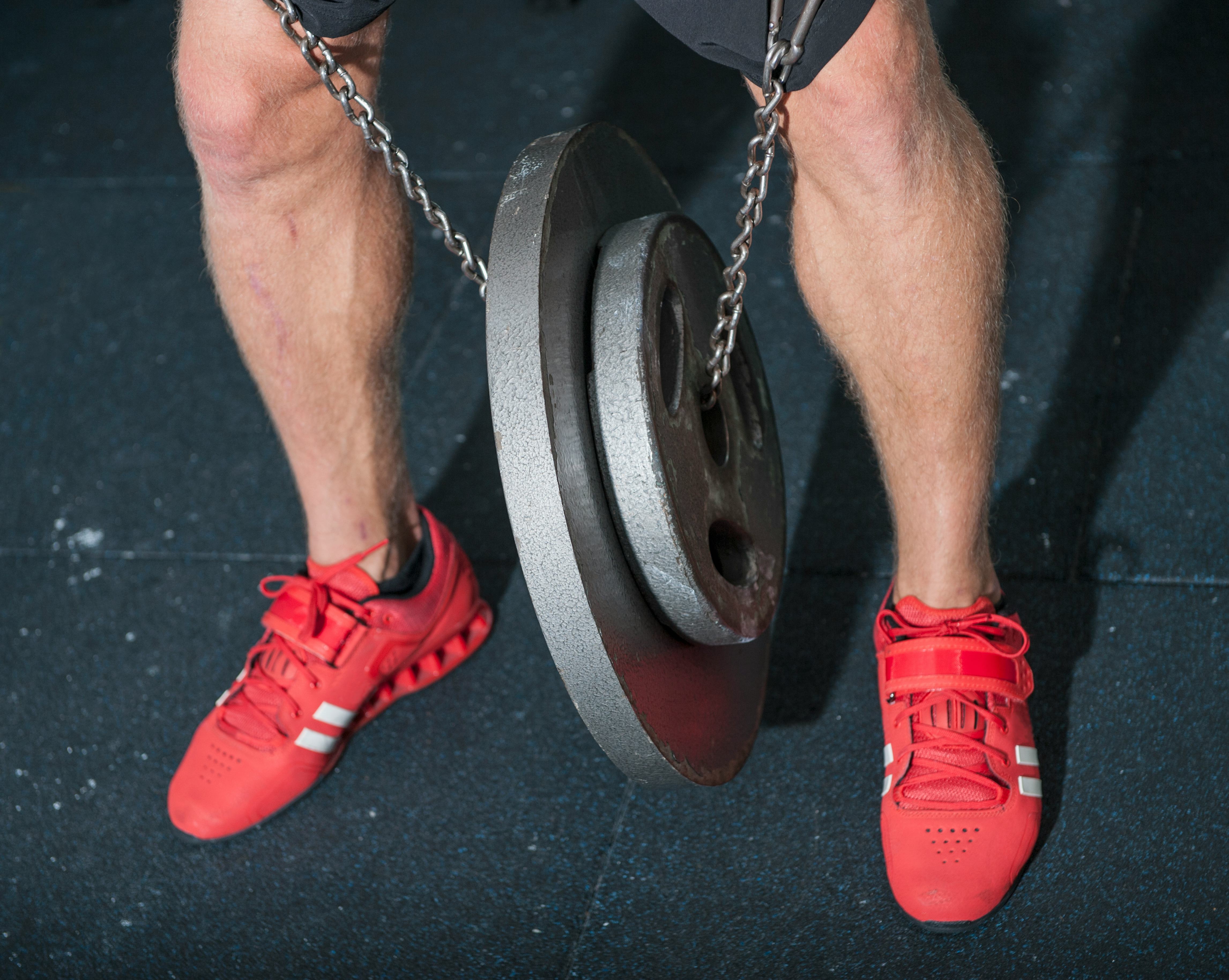
The best gyms are altars to specificity. They have weights in 2.5-pound increments, endless machines, squat racks, barbells for squats and pulls, mobility trinkets, bands, cables, and space: the helpful extras that take a workout from good to great.
But getting strong is not an equipment-heavy endeavor. Gear doesn’t work magic for lifters any more than hard work does, and a simple home gym — a couple of barbells, a kettlebell, bands, a pull-up bar — is enough to put on muscle and strength. Professional gyms free lifters from even more equipment. We don’t need to own anything. We just need to lift.
Shoes, though, are equipment of a different sort. Lifters wear different kinds, and the debate over which is best can get pretty fractious. Why do shoes matter — or do they? And which ones to pick?
We can categorize lifters by everything from the programs they choose — or whether they even follow one — to their approaches to cardio. Looking at their shoes can be the best way to figure out their goals.
What are the best shoes for lifting weights?
Shoes should correspond to a program’s most dominant exercises. Olympic-style weightlifters do their squats and lifts in sneakers with raised, incompressible heels — sometimes called squat shoes — or more official Olympic weightlifting shoes.
Those lifts make up much of their training. The stacked heels, an inch or so high, allow the ankles to bend forward more than they would normally. This lets lifters stay over the bar on snatches, and stand upright when squatting. The heels sometimes stay on during pulls, the sport’s deadlift equivalent. Olympians tend to wear squat shoes from Adidas, Nike, or Asics, but other brands, like Do-Win, can be found cheaper and are comparable technically for folks just starting off.
Bodybuilding, which emphasizes an aesthetic display of pretty big muscles, is murkier because its lifts vary. Isolation exercises with dumbbells don’t require specialty footwear, which is why you might see an incredibly jacked individual lifting in Timberlands, or sneakers with visible air.
Shoes are less inextricable from programming, though they matter, especially on compound exercises. Many bodybuilding programs include squats and deadlifts. Bodybuilders used to go barefoot under the bar — check out this photo of Arnold — and those occasional compound lifts demand either that or non-technical footwear. Squat shoes are fine and flat sole, incompressible sneakers — specifically Converse Chuck Taylors, or Vans — also work.
Powerlifting falls in the middle. Olympic lifters only train one kind of squat — high bar, more on that later — and bodybuilders might do several, but powerlifters, who compete in that lift, tend to pick theirs. In that sport, the squat is not a training lift, but a goal in itself and so choice enters into it. A squat is trained for poundage. It’s not done to build up the snatch or to put on size, and it may not necessarily be upright.
But which squat is best? That debate — how to squat — is behind the sneaker debate in the sport.
Shoes and squats: High bar or low?
There are two types of squats, high-bar and low, whose names correspond to where the bar’s placed on the back.
The distinction is important but cloudy. Most programs don’t say how to squat, just that you should. The high-low bar consensus might depend on the year you get into the sport. Trends wax and wane. But the way you squat really depends on your goals.
A high-bar squat rests the weight on the lifter’s trapezius muscles, below the neck. It’s the weightlifting version and forces the lifter upright. A high-bar squat targets quads the most — they lift up the weight — and is designed to train weightlifting, where lifters stand upright below a raised barbell.
It demands mobile ankles — try and squat with your back ramrod straight and your knees out and forward — which necessitates lifting shoes. Stacked heels can also prevent internal knee collapse on a lift. Squat shoes — Adidas Adipowers, Asics 727s Nike Romaleos, Do-Wins —make upright squats easier and more stable, and are just about necessary for Olympic lifters.
A low bar squat — the lifter hinged forward, bar resting below their traps, locked in with bent elbows, feet placed wide — is almost a different exercise from the high bar variety. With the weight placed lower on the back, the torso leans forward, and hips are worked more than with a high bar. A low-bar squat is more an expression of strength than technique: with hamstrings and glutes more involved, a low bar squat can move more weight up and down.
For these reasons, this squat tends to be preferred by extremely competitive powerlifters, the kinds who set records. A low-bar lifter who is already leaning forward might lean forward too much if they wear squat shoes. Often, Chucks or Vans are ideal.
One squat isn’t better than the other: low-bar builds up power and the posterior chain; high-bar strengthens the quads and spinal erectors. But picking one over the other determines your path. Some lifters will be better at one or the other for biological reasons, but all lifters will have to veer to one form over another. Lifting in Chucks means you’re either just starting off or a serious powerlifter. Lifting in squat shoes means you’re going upright, and possibly training other lifts. We can’t always tell what program someone’s on just by looking at their lifts. But we can get some idea if we check out the shoes they’re wearing on the most important lift that there is.
Why sneakers shape workouts
There aren’t as many studies on squat shoes as there are on running shoes. A 2020 study published in the journal PeerJ found muscles were more activated on low bar squats compared to high, especially glutes and hamstrings. However, the study’s cohort — competitive powerlifters training for a meet — may have been more versed in low bar squats at the start, and the study’s less about shoes than about the difference in lifts.
Shoes might define training, but they shouldn’t matter enough to delay it. Some lifters squat low bar in weightlifting shoes, and some do high in Chucks, but there are affordable options for the former — Adidas and Rogue models can run at about $100, and Craigslist and eBay often have never-worn pairs from lifters who’ve had changes of heart.
If you can’t get weightlifting shoes right away, you can squat in Chucks with plates under your heels. That might be the best option to start with. Spend the money on a trainer and drill down your squat form. You probably won’t be lifting a very heavy weight at this stage anyway.
Chucks and weightlifting shoes are both fine for cardio unless the lifter is running five miles after a workout. Hybrid shoes — Crossfit-type sneakers with incompressible heels, only shorter — are another option. They’re designed for running, squatting, and circuits.
When lifters advance, they have a license to become more specific. I know one elite lifter who wears squat shoes for squatting, wrestling slippers for deadlifts, Chucks for everything else, and runners for cardio. It feels like too much, but I’m not sure it is. It’s his money, and he likes working out.
Sneakers in lifting are strange. They’re not technical — they don’t determine results — but they shape workouts. The shoe you choose limits your ankle angle and defines your squat — and your squat defines your goals. In both cases, though, it’s an incompressible shoe without any technology. Whether high-bar or low, all that matters is poundage. The shoes can’t put weight on the bar. It’s a reminder of strength’s harsh, binary nature.
LEG DAY OBSERVER is an exploratory look at fitness, the companion to GQ.com’s Snake America vintage column, and a home for all things Leg Day. Due to the complicated nature of the human body, these columns are meant to be taken as introductory prompts for further research and not as directives. Read past editions of Leg Day Observer for more thoughtful approaches to lifting and eating.







